|
Introduction
Small Research Telescope Challenge
Undergraduate Student Research and
Telescope Development
Introduction
The Alt-Az
Initiative is a catalyst for the development of low cost,
lightweight, modest aperture (2 meters and less) alt-az research
telescopes. Such telescopes, especially when automated and
networked, can be cost-effective tools for dedicated research
programs including low and high resolution fiber-fed
spectroscopy as well as optical, near infrared, and high speed
photometry. To date,
two full conferences and twelve workshops have been
completed. Twelve technical initiatives have been completed or
are underway. These include optical designs, lightweight
mirrors, active primary mirror controls, and direct drive motors
and controllers. One low cost, lightweight, technical
demonstration telescope with lightweight mirrors, a lightweight
structure, and direct drives has been completed. Future
technical initiatives and technical demonstration telescopes are
outlined.
Two books,
Small Telescope and Astronomical Research and The Alt-Az
Initiative: Telescope, Mirror, and Engineering Developments,
based on these meetings, initiatives, and the demonstration
telescope, are now available.
Small
Research Telescope Challenge
Small Research Telescopes
Their Enduring
Value: In the age of giant telescopes, are
small telescopes still useful? Weaver (2003) points out that
Both
quantitative and qualitative arguments demonstrate the
continuing importance of small telescopes to the astronomical
endeavor. The quantitative arguments show that it is
significantly less expensive per citation to use the smallest
telescope that will accomplish the research. Both the
quantitative and qualitative arguments show that the research
accomplished by small telescopes is of continuing and lasting
significance to the discipline as witnessed by their
non-diminishing contribution to astronomy over the last century
and the persistence of their citation histories.
Ringwald et al
(2003) suggests that
Small
telescopes can hold their own with larger instruments since more
time is available on them. This makes possible monitoring
campaigns, aerial surveys, and time-resolved campaigns,
particularly if the telescopes are networked or automated—all
difficult to carry out with larger telescopes, for which even
small amounts of telescope time are in great demand.
The 2007 report of the Committee for Renewing Small
Telescopes for Astronomical Research (ReSTAR) concluded that
The science to be done with small and mid-size telescopes
remains compelling and competitive in the era of big telescopes.
Small and mid-size telescopes continue to produce innovative
science in themselves, and to provide precursor and follow up
observations that enhance the scientific productivity of larger
telescopes. Small and mid-size telescopes also enable
scientific investigations that are not possible on larger
telescopes.
The ReSTAR
report went on to state that
Small and
mid-size telescopes contribute additionally to the discipline
through their training and educational functions and as test
beds for innovative new instrumentation and techniques.
The Challenge
Increasing
Participation through Greater Affordability
Weaver (2003)
recalls that
Astronomy has a
history of an essential synergy between small and large
telescopes. This synergy can be maintained only if there is a
reasonable number of well-maintained, well-instrumented
smaller-sized telescopes.
Budget realities suggest, however, that both national and
large-institution funding of expensive to build and operate but
vital cutting edge large telescopes will make it difficult to
also fund smaller telescopes in sufficient numbers to maintain
an optimal balance between large and small telescopes. Further,
during hard economic times, it will also be increasingly
difficult for smaller institutions to fund small research
telescopes themselves. So what is to be done? How can we
maintain the balance and the synergy between large and small
telescopes?
Meeting the Challenge
Lowering Costs
through Advanced Technology and Quantity Production
In his book, Excursions in Astronomical
Optics, Lawrence Mertz (1996), after noting that there is a
“crying need for more observational facilities to outfit the
throngs of young astronomers,” offered a solution:
The
remedy, it seems to me, would be a proliferation of modest-sized
telescopes in the 1.5- to -2-meter class that are sufficiently
standardized for economy. The size is large enough to accomplish
significant work, yet is small enough to become affordable if
the design were standardized. All too frequently small
institutions insist upon designing their own telescopes almost
from scratch to fulfill their individual tastes. It should be
evident that that course is hopelessly uneconomical, just as it
would be uneconomical for each automobile to be custom designed.
In essence, what is needed for observational astronomy is
numerous … relatively inexpensive telescopes in the 1.5- to
2-meter class. Even at this modest size there does not remain
much question between altitude-azimuth (alt-az) and equatorial
mounting; computers now make the former more economical. Alt-az
has the further advantage of simplifying the primary mirror
support since tilting is restricted to the elevation axis.
We can expand on two of Mertz’s vital points. First, advances
in technology, especially in computers and electronics—but also
materials and other areas—can reduce telescope costs. Mertz
illustrated this with an obvious example—shifting from
equatorial to alt-az mounts. Second, true economy can only be
achieved through quantity production. “One-off” telescopes will
always be expensive. Although Mertz did not mention it, a third
point could also have been made: large “one-off” telescopes
with their sizeable development budgets often pioneer the new
technologies which subsequently migrate to small production
telescopes. These “tech transfers” are completed once clever
ways are devised to drastically reduce costs so that the large
telescope technologically-inspired breakthroughs can be
incorporated economically into small telescopes in quantity
production.
Two Telescope
Tech Transfer Examples
Consider, as the first tech transfer example, alt-az
telescopes themselves. The 5-meter Hale telescope, completed
over a half century ago, remains the largest equatorial
telescope ever built. There are now over 20 larger telescopes.
Every single one is alt-az. Smaller telescopes are also
heading down this same evolutionary pathway.
Until recently, most truly small (less than 1 meter)
telescopes remained equatorial because alt-azimuth telescopes
not only required constantly changing drive rates in both
altitude and azimuth, but to avoid image smearing also required
a field de-rotator—a significant complication. However, these
complications did not apply to visual-only, manually operated,
non-tracking alt-az telescopes. In their search for larger
apertures at low cost, Amateur astronomers recognized the
inherent advantages of an alt-az over an equatorial
configuration. Today, low cost, easily transported, and now
mass produced “Dobsonian” telescopes. Now one can purchase
quantity manufactured Dobsonian telescopes from 4 to 32 inches
in aperture that cost from $100 to $34,000. There are even a
few larger and more expensive “Dobs” out there.
Mel Bartels (1994, 1999, and 2000) developed a very low cost
control for alt-az telescopes that employed a personal computer,
a small electronics board, and three stepper motors for,
respectively, altitude, azimuth, and instrument rotation. Soon
Mel’s Compan, BB Astrosystems was selling the alt-az control
system electronics for a very low cost. The user supplied the
stepper motors and a personal computer and computerized their
Dobsonian telescopes. More recently, Dan Gray’s Sidereal
Technology has offered the electronics and software for a
complete alt-az, DC servo control system, including instrument
rotation and focus for about $1000. Dan graciously suggested he
was inspired by Microcomputer Control of Telescopes (Trueblood
and Genet 1985).
For the second example of tech transfer from large to small
alt-az telescopes, consider telescope weight, stiffness, and
materials. As computers became more powerful, finite element
analysis (FEA) resulted in increasingly lightweight yet stiffer
large telescopes—leading eventually to today’s highly optimized
truss structures. Lighter weights lowered costs, while stiffer
structures allowed control systems to more effectively counter
wind gusts. Stiff and economical steel remained the material of
choice for large alt-az telescopes.
Dobsonian telescopes also evolved to become much lighter,
stiffer, and more truss like. They shifted from ordinary
plywood and cardboard Sonatubes to hardwood veneer plywood and
aluminum trusses. A recent small alt-az telescope, the 18-inch
Cal Poly telescope (discussed further below), was designed by
undergraduate engineering students using FEA, and features a
carbon fiber composite structure. Carbon fiber composites have
about three times the stiffness to weight ratio of steel.
Although carbon fiber is too expensive a material to use in
large telescopes, they can be an advantage in smaller
telescopes.
A good example of a modern, lightweight, alt-az telescope is
Howard Banich’s (2004) 28-inch, computer-controlled, all
aluminum alt-az telescope which weighs about 330 lbs. Howard
transports his telescope in the back of a VW Eurovan, and can
assemble or disassemble it in less than ten minutes. Watch
Howard in action in a time-lapse video at
http://hbanich.googlepages.com/
28inchteardownvideo.
A somewhat similar telescope, SpicaEyes, is available
commercially in apertures up to 32 inches.
|
(Left) Howard
Banich’s portable 28 inch telescope at the first Alt-Az
Initiative Workshop in Portland, June 2007. Howard is
on the left, and Russ Genet is on the right. (Right) One
of SpicaEyes commercially produced all-aluminum,
computer-controlled alt-az telescopes. |
It might be noted in passing that not all tech transfers have
been from large to small telescopes. Full telescope and
observatory automation, remote Internet access, and global
networking have all been pioneered by small telescopes. Larger
telescopes subsequently adopted aspects of these technologies.
These are all clear cases of reverse tech transfer.
Two Separate
Telescope Development Communities
Although large to small alt-az telescope tech transfer is
taking place, the fact is that the large and small developmental
communities are, in the main, quite separate, with limited
between-community communications. Large alt-az telescope
developments are generally undertaken by a combination of paid
professional engineers and astronomers. These telescopes are
built in high-bay machine shops equipped with large cranes. The
cost of such telescopes now often exceeds $50 million, and the
telescopes can weigh over 1 million pounds. Each telescope
development is, typically, unique. Information is exchanged
through the meetings and journals of engineering organizations
such as the Society of Photo-optical Instrumentation Engineers (SPIE),
and through professional astronomical meetings such as those
organized by the American Astronomical Society (AAS). A classic
large telescope design book is The Design and Construction of
Large Optical Telescopes (Beley 2003).
The development of small, Dobsonian alt-az telescopes, on the
other hand, has mainly been undertaken by unpaid amateur
telescope makers (ATMs) as an avocation. It might be noted,
however, that many ATMs are, by vocation, scientists, engineers,
or technicians. These telescopes are being built at home or
small manufacturing shops, often with simple tools. Costs are
typically a few thousand dollars, and telescopes weigh a few
hundred pounds. Although many ATM-built telescopes are unique,
several small telescope manufacturers produce identical
telescopes in quantity. Information is not only exchanged
on-line through a variety of email lists and web sites, but also
through annual regional conferences such as the Riverside
Telescope Makers Conference (RTMC). The quarterly journal,
Amateur Telescope Making, which was the primary published
record for Dobsonian developments for many years, has now been
superseded by Amateur Astronomer. Sky & Telescope
and Astronomy Technology Today also feature small
telescope developmental articles. A classic small telescope book
is The Dobsonian Telescope (Kriege and Berry 2003).
Instrumentation
The past decade has seen great advances in the availability
of research grade instrumentation suitable for smaller
telescopes. These advances have been driven by a combination of
evolving technology and by the emergence of a community of
advanced amateur astronomers with modest budgets but very high
standards.
This combination has allowed instrument makers such as
SBIG, Optec,
Shelyak, and others to bring to market products with
capabilities that were previously available only to well
financed institutions. Equally important has been the emergence
of a software infrastructure (ASCOM) that unifies instrument
automation and telescope control.
To give just a few examples of progress over the last
decade: High quantum efficiency, science grade imaging cameras
have gone from 1.5 mega pixels (MP) to 16 MP. Small telescope
spectrographs, a category that hardly existed a decade ago, now
include R~17K Littrow and fiber fed Echelle instruments. The
cost of polarimetric instruments has declined by a factor of 10
thanks to achromatic polymer waveplates from Bolder Vision Optik.
And whole new instruments are now available such as the
SSP-4 that
provide JH band infrared photometry. Small telescope IR
spectrographs and imagers are within sight.
These individual instruments are generally lightweight, well
documented, essentially maintenance free, and have multivendor
software support. Moreover, they were designed to match
telescopes in the .3m to 1.5 meter range because that is where
their customers are.
Dedicated
Telescopes, Automation, and Operation and Maintenance Costs
General purpose telescopes, which have to meet a
wide range of requirements, tend to be more expensive than
dedicated telescopes to purchase, and certainly are more
expensive to operate and maintain. The initial cost of a general
purpose telescope at a major observatory, while it can be
considerable, is typically much smaller than the long run
operation and maintenance (O&M) costs over the telescope’s life
time. The cost of paying O&M staff for decades adds up.
Furthermore, the cost of the instruments, substantial to begin
with and expensive to upgrade over the years, can be a large
fraction of the life cycle cost. The long-term burden of O&M
costs at the national observatories became so high that a number
of smaller scopes had to be closed because there was
insufficient money both to operate them and also build and
operate new, larger, cutting-edge research telescopes.
Taking instruments on and off a telescope on a
regular basis is costly in both manpower and equipment wear and
tear. Dedicated telescope/instrument combinations, on the other
hand, can be designed together for a specific mission area with
the instruments permanently emplaced on the telescope. A
computer-controlled selector moves the optical beam between the
instruments in a cluster. Dedicated telescopes may be the way of
the future, because they are cheaper to operate and maintain,
particularly when they are operated in a service/robotic mode.
If a dedicated telescope with a permanent, computer
selectable cluster of instruments is run robotically, care has
been taken to obtain high reliability components, and
maintainability issues have been carefully addressed, then O&M
costs can be quite low. The National Science Foundation has
traditionally funded the telescopes at colleges and
universities, but not, of course, for individuals. However, if
small, dedicated, robotic research telescopes could be made
inexpensively enough, they might become affordable enough for
individuals and small informal groups entirely on their own to
purchase, operate, and maintain.
Undergraduate Student Research and Telescope Development
The Initiative is actively pursuing the vital connection
between small telescopes and the training of a new generation of
astronomers and instrumentalists. A number of institutions with
limited budgets are developing research programs that utilize
low cost telescope technology. To date, several dozen
undergraduate students at
Cuesta College have
participated in astronomical research programs resulting in
published papers. They utilize both local observatories and
remote, robotic observatories to observe a wide range of
celestial phenomena including visual double stars, eclipsing
binaries, intrinsic variable stars, asteroid rotation rates, and
exoplanet transits.
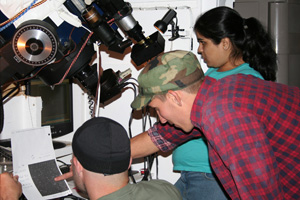 |
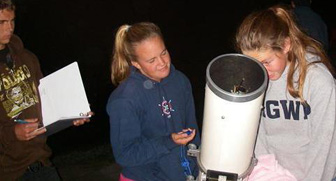 |
|
Cuesta
College research seminar students observe an intrinsic
variable star (left) and Arroyo Grande High School
students (taking a Cuesta College research seminar) make
astrometric measurements of visual double stars (right).
Their results have been published in
Society for Astronomical Science Symposium Proceedings,
The Alt-Az Initiative (book in press), and the
Journal of Double Star Observations. |
Similarly, a dozen California Polytechnic State University,
San Luis Obispo (Cal Poly) engineering (ME and EE) students have
been or are currently involved in the design and fabrication of
a research grade alt-az telescope, instrument rotator, and low
cost, active primary mirror support electronics.
|
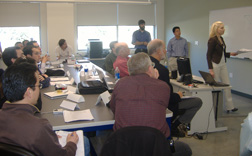 |
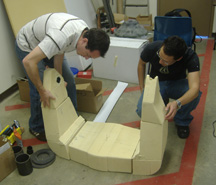 |
|
The Cal
Poly engineering students present their design for an
18-inch Newtonian focus alt-az telescope at a critical
design review (left). Two Cal Poly ME students fabricate
the fork of the telescope. They designed the fork using
finite element analysis (right). The foam core was later
covered with multiple layers of carbon fiber cloth. |
These research and engineering students have given
presentations at multiple Initiative workshops and conferences,
and have coauthored Initiative papers. One
Cuesta
College student, Jo Johnson, co-chaired two Initiative
conferences and is co-editing the Initiative’s forthcoming book.
|
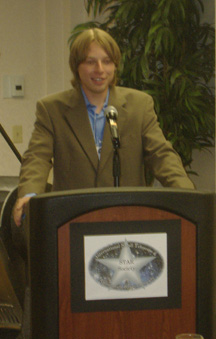 |
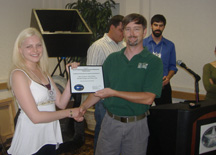 |
|
Cuesta
College student
Jolyon Johnson co-chaired two conferences for the Alt-Az
Initiative: the
STAR Conference
in
California
(left) and Galileo’s Legacy in Hawaii. Cal Poly engineering student Michelle Kirkup receives a certificate of
recognition from Professor John Ridgely at the
STAR Conference
for her participation in designing the Cal Poly 18-inch
alt-az telescope (right). |
|
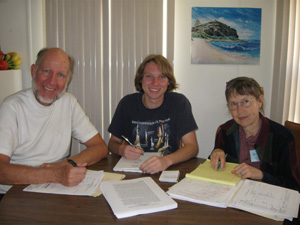 |
Lightweight
Alt-Az Telescope Developments
Edited by
Russell Genet, Jolyon Johnson, & Vera Wallen
|
|
|
Russell
Genet, Jolyon Johnson, and Vera Wallen (left to right)
are editing the Initiative’s book
Lightweight
Alt-Az Telescope Developments. This book discusses
all aspects of the Initiative in detail (left). The
cover of the Initiative book features the Initiative’s
first production spin-off, PlaneWave Instruments CDK 700
telescope silhouetted against the galaxy M81 (right). |
back to top |